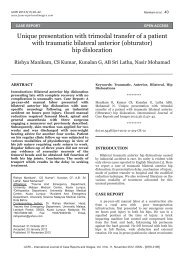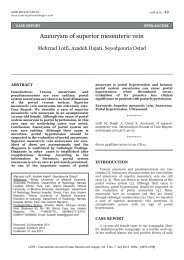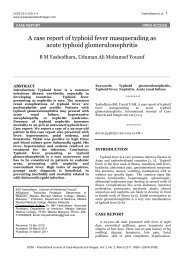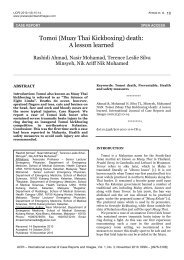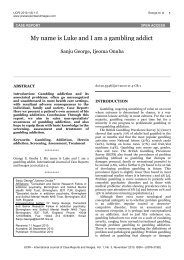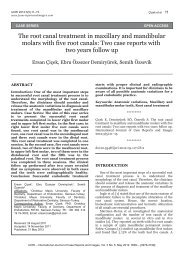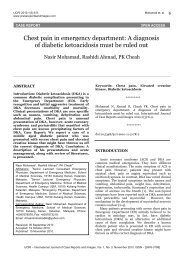Provisional PDF - International Journal of Case Reports and Images ...
Provisional PDF - International Journal of Case Reports and Images ...
Provisional PDF - International Journal of Case Reports and Images ...
You also want an ePaper? Increase the reach of your titles
YUMPU automatically turns print PDFs into web optimized ePapers that Google loves.
IJCRI 201 2;():****.<br />
www.ijcasereports<strong>and</strong>images.com<br />
Roy et al. 2<br />
Portal hypertension is a rare complication <strong>of</strong><br />
choledochal cyst. The treatment <strong>of</strong> choledochal cyst<br />
complicated by portal hypertension has evolved from<br />
internal drainage <strong>of</strong> cyst to single stage excision <strong>of</strong> cyst<br />
with bilioenteric anastomosis. Portal decompression is<br />
reserved for cases with extensive collaterals in the<br />
hepatoduodenal ligament. Here we report a case <strong>of</strong><br />
choledochal cyst with portal hypertension.<br />
CASE REPORT<br />
A 15yearold young female presented with typical<br />
traid <strong>of</strong> abdominal pain <strong>and</strong> abdominal lump for one<br />
year <strong>and</strong> jaundice for eight months. For last two months<br />
she also had pruritus with passage <strong>of</strong> clay colored stools.<br />
There was no previous history <strong>of</strong> acute cholecystitis,<br />
pancreatitis, hematemesis or melena. On biochemical<br />
investigations hemoglobin was 8.3 g/dl, serum bilirubin<br />
6.3 mg/dl, serum SGOT 258U/L, serum SGPT 105 U/L,<br />
serum alkaline phosphatase 711 IU/L <strong>and</strong> albuminglobulin<br />
ratio was 1:1.2. Viral markers for hepatitis B<br />
<strong>and</strong> C were negative. Abdominal ultrasonography<br />
showed a large cystic lesion <strong>of</strong> size 11.5x13 cm in<br />
epigastric region, hepatosplenomegaly with<br />
heterogenous coarse echotexture <strong>of</strong> liver, dilated<br />
Figure 1: Magnetic Resonance Cholangiopancreatography<br />
(MRCP) suggestive <strong>of</strong> choledochal cyst <strong>and</strong> dilated intrahepatic<br />
biliary radicle.<br />
intrahepatic biliary radicle (IHBR) <strong>and</strong> common bile<br />
duct (CBD). Proximal CBD measured 2.2 cm with nonvisualization<br />
<strong>of</strong> distal portion.<br />
On further investigating the patient, MRCP showed a<br />
large cystic dilatation <strong>of</strong> CBD measutring 11.8x11.6x11.6<br />
cm (typeI choledochal cyst) with minimum sludge in<br />
dependent position likely to be choledochal cyst. Also<br />
seen were dilated IHBR <strong>and</strong> hepatic ducts, nodular liver,<br />
splenomegaly, displaced portal vein with recanalization<br />
<strong>of</strong> left umbilical vein <strong>and</strong> ascites (Figure 1). An upper<br />
gastrointestinal endoscopy revealed grade I esophageal<br />
varices with proximal gastropathy. Serumascites<br />
albumin gradient (SAAG) was >1.1 g/dl wich was<br />
suggestive <strong>of</strong> portal hypertension.<br />
A preoperative diagnosis <strong>of</strong> choledochal cyst with<br />
portal hypertension was made <strong>and</strong> single stage operative<br />
procedure which included excision <strong>of</strong> the choledochal<br />
cyst with bilioenteric anastomosis was planned.<br />
Intraoperatively large focal segmental dilation <strong>of</strong> CBD<br />
below the cystic duct (typeIB choledochal cyst)<br />
displacing the portal vein on left with dense adhesions<br />
between the portal vein <strong>and</strong> posterior wall <strong>of</strong> the<br />
choledochal cyst, <strong>and</strong> splenomegaly with multiple<br />
collaterals in the hepatoduodenal ligament were evident.<br />
The posterior wall <strong>of</strong> the choledochal cyst could not be<br />
separated from the portal vein; so partial excision <strong>of</strong> the<br />
cyst with stripping <strong>of</strong> the mucosa <strong>of</strong> the posterior wall <strong>of</strong><br />
the cyst along with a rouxenY hepaticojejunostomy<br />
was performed. The post operative period was<br />
uneventful <strong>and</strong> the histopathological examination was<br />
suggestive <strong>of</strong> an inflamed choledochal cyst. At 16<br />
months <strong>of</strong> follow up the patient was well with complete<br />
regression <strong>of</strong> esophageal varices.<br />
DISCUSSION<br />
With advancement <strong>of</strong> imaging modality, incidence <strong>of</strong><br />
adult choledochal cyst is on rise. Incidence in Asia is<br />
somewhat higher than in western countries. The reason<br />
for this geographical difference is still unclear [1, 2].<br />
There is also an unexplained female preponderance with<br />
female:male ratio commonly reported as 4:1. The most<br />
widely accepted hypothesis regarding etiology is an<br />
anomalous arrangement <strong>of</strong> the pancreaticobiliary ductal<br />
junction [3, 4]. Choledochal cyst is a disease <strong>of</strong> infancy<br />
<strong>and</strong> childhood but about 20% are not diagnosed until<br />
adulthood [57]. Choledochal cysts in adults are more<br />
commonly associated with hepatobiliary pathology <strong>and</strong><br />
complications <strong>of</strong> previous cyst related procedures [1, 6,<br />
7]. The complications include cystolithiasis,<br />
hepaticolithiasis, cholangitis, calculous cholecystitis,<br />
pancreatitis, pancreatic duct abnormalities, malignancy<br />
<strong>and</strong> portal hypertension. Cystolithiasis is the most<br />
frequent complication in adults with choledochal cyst<br />
with a prevalence rate ranging from 272% [7]. The<br />
treatment <strong>of</strong> choice <strong>of</strong> choledochal cyst is excision <strong>of</strong><br />
cyst with bilioenteric anastomosis. In conditions where<br />
complete excision <strong>of</strong> cyst is not possible due to adhesion<br />
with vital structures, partial excision <strong>of</strong> cyst with<br />
stripping <strong>of</strong> mucosa <strong>of</strong> the part <strong>of</strong> cyst left insitu can be<br />
ACCEPTED MANUSCRIPT<br />
PROVISIONAL <strong>PDF</strong><br />
IJCRI – <strong>International</strong> <strong>Journal</strong> <strong>of</strong> <strong>Case</strong> <strong>Reports</strong> <strong>and</strong> <strong>Images</strong>, Vol. No. , 201 2. ISSN – [0976-31 98]



